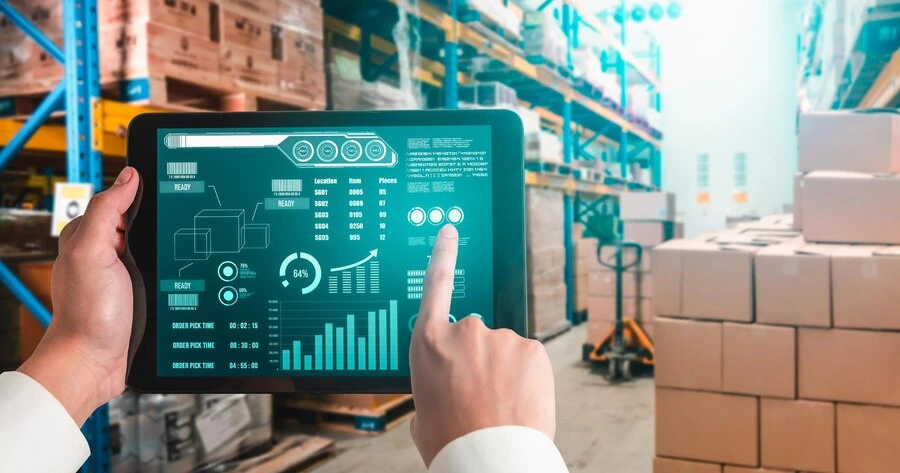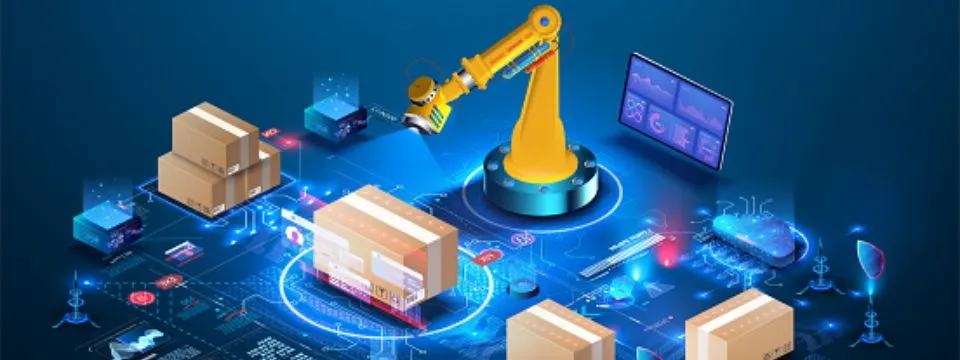How IoT Can Improve Warehouse Management
Author: Laila Meraj
17 October, 2024
In the rapidly evolving landscape of modern logistics and supply chain management, warehouses play a crucial role in ensuring the smooth flow of goods from manufacturers to consumers. As businesses strive to meet increasing consumer demands and maintain a competitive edge, the integration of Internet of Things (IoT) technology has emerged as a game-changer in warehouse management.
This comprehensive guide explores how IoT can significantly improve warehouse operations, enhance output, and drive overall business growth.

Understanding IoT in Warehouse Management
The Internet of Things refers to the network of interconnected devices that can collect, transmit, and analyze data without human intervention. In the context of warehouse management, IoT encompasses a wide range of sensors, smart devices, and software systems that work together to optimize various aspects of warehouse operations.
Key Components of IoT in Warehouses
- Sensors: These devices collect data on environmental conditions, inventory levels, equipment status, and more.
- RFID tags and readers: Used for tracking inventory and assets throughout the warehouse.
- Smart shelves and bins: Equipped with weight sensors to monitor stock levels in real-time.
- Automated Guided Vehicles (AGVs): Self-driving vehicles that can transport goods within the warehouse.
- Wearable devices: Used by warehouse staff for hands-free access to information and task management.
- Cloud-based management systems: Centralized platforms that process and analyze data from various IoT devices.
Benefits of Implementing IoT in Warehouse Management
Enhanced Inventory Management
One of the most significant advantages of IoT in warehouse management is its ability to revolutionize inventory tracking and management. Traditional inventory methods often rely on manual counts and periodic audits, which can be time-consuming, error-prone, and fail to provide real-time insights.
IoT-enabled inventory management systems use RFID tags, smart shelves, and weight sensors to continuously monitor stock levels. This real-time data allows warehouse managers to:
- Maintain optimal inventory levels
- Reduce stockouts and overstock situations
- Implement more effective just-in-time (JIT) inventory strategies
- Improve demand forecasting and supply chain planning
For example, smart shelves equipped with weight sensors can automatically detect when inventory levels fall below a certain threshold and trigger reorder requests. This proactive approach ensures that popular items are always in stock while minimizing excess inventory of slow-moving products.
Improved Space Utilization
Efficient use of warehouse space is crucial for maximizing storage capacity and reducing operational costs. IoT technology can help optimize space utilization through:
- 3D mapping and visualization of warehouse layouts
- Real-time monitoring of available storage space
- Dynamic allocation of storage locations based on current inventory levels and product characteristics
By leveraging IoT data, warehouse managers can make informed decisions about space allocation, identify underutilized areas, and implement more effective storage strategies. This can lead to increased storage capacity without the need for physical expansion, ultimately reducing real estate costs and improving overall efficiency.
Enhanced Picking and Packing Efficiency
Order fulfillment is a critical process in warehouse operations, and IoT technology can significantly improve its efficiency. Some ways IoT enhances picking and packing include:
- Optimized picking routes: IoT-enabled systems can calculate the most efficient paths for order pickers, reducing travel time and increasing productivity.
- Voice-directed picking: Wearable devices with voice recognition capabilities allow workers to receive picking instructions hands-free, improving accuracy and speed.
- Automated sorting systems: IoT-enabled conveyor belts and sorting machines can automatically route items to the correct packing stations, reducing manual handling and errors.
These improvements in picking and packing efficiency can lead to faster order fulfillment times, increased accuracy, and higher customer satisfaction rates.
Improved Asset Tracking and Management
Warehouses often contain valuable equipment and assets that need to be tracked and maintained. IoT technology enables more effective asset management through:
- Real-time location tracking of equipment and tools
- Predictive maintenance based on usage data and performance metrics
- Automated alerts for equipment malfunctions or required servicing
By implementing IoT-based asset tracking systems, warehouses can reduce equipment downtime, extend the lifespan of assets, and optimize resource allocation.
Enhanced Safety and Security
IoT technology can play a crucial role in improving warehouse safety and security. Some applications include:
- Environmental monitoring: Sensors can detect changes in temperature, humidity, or the presence of harmful gases, triggering alerts to prevent product damage or ensure worker safety.
- Access control systems: IoT-enabled security systems can monitor and control access to different areas of the warehouse, enhancing overall security.
- Worker safety monitoring: Wearable devices can track worker locations and vital signs, alerting supervisors to potential safety hazards or emergencies.
By leveraging IoT for safety and security, warehouses can create a safer working environment, reduce accidents, and protect valuable inventory and assets.
Data-Driven Decision Making
One of the most powerful benefits of IoT in warehouse management is the wealth of data it generates. This data can be analyzed to derive valuable insights and support data-driven decision making. Some areas where IoT data can inform strategic decisions include:
- Performance optimization: Identifying bottlenecks and inefficiencies in warehouse processes
- Demand forecasting: Analyzing historical data to predict future inventory needs
- Resource allocation: Optimizing staffing levels based on workload patterns
- Continuous improvement: Tracking KPIs and implementing data-driven process improvements
By leveraging advanced analytics and machine learning algorithms, warehouse managers can turn IoT data into actionable insights that drive continuous improvement and strategic growth.
Challenges and Considerations in Implementing IoT for Warehouse Management
While the benefits of IoT in warehouse management are significant, there are several challenges and considerations to keep in mind when implementing these technologies:
Initial Investment Costs
Implementing IoT systems often requires a substantial upfront investment in hardware, software, and infrastructure. Warehouses need to carefully evaluate the potential ROI and develop a phased implementation plan to manage costs effectively.
Integration with Existing Systems
Many warehouses already have established management systems in place. Integrating IoT technologies with these legacy systems can be complex and may require custom development or middleware solutions.
Data Security and Privacy
With the increased collection and transmission of data, ensuring the security and privacy of sensitive information becomes crucial. Warehouses need to implement robust cybersecurity measures and comply with relevant data protection regulations.
Scalability and Flexibility
As warehouse operations grow and evolve, IoT systems need to be scalable and flexible enough to accommodate changing needs. Choosing solutions with open architectures and standardized protocols can help ensure long-term scalability.
Employee Training and Adoption
Introducing new technologies often requires significant changes in work processes and employee skill sets. Comprehensive training programs and change management strategies are essential for successful IoT implementation.
Future Trends in IoT-Enabled Warehouse Management
As IoT technology continues to evolve, several emerging trends are likely to shape the future of warehouse management:
Artificial Intelligence and Machine Learning
The integration of AI and machine learning algorithms with IoT data will enable more advanced predictive analytics, autonomous decision-making, and optimization of warehouse processes.
Edge Computing
Processing data closer to the source (at the “edge” of the network) will reduce latency and enable real-time decision making for critical warehouse operations.
5G Connectivity
The rollout of 5G networks will provide faster, more reliable connectivity for IoT devices, enabling more sophisticated applications and real-time data processing.
Blockchain Integration
Combining IoT with blockchain technology can enhance supply chain transparency, improve traceability, and increase the security of data exchanges between stakeholders.
Advanced Robotics and Automation
The integration of IoT with more advanced robotics and automation systems will lead to increasingly autonomous warehouse operations, with minimal human intervention required for routine tasks.
Conclusion
The Internet of Things is revolutionizing warehouse management by providing unprecedented visibility, control, and optimization capabilities. From enhancing inventory management and improving space utilization to increase operational efficiency and support data-driven decision-making, IoT technologies offer a wide range of benefits for modern warehouses.
Xorbix Technologies is a leading provider of innovative IoT solutions for warehouse management and supply chain optimization. With a team of experienced professionals and cutting-edge technology, Xorbix helps businesses streamline their operations, improve efficiency, and drive growth through data-driven insights and advanced automation.
Read more related to this blog:




